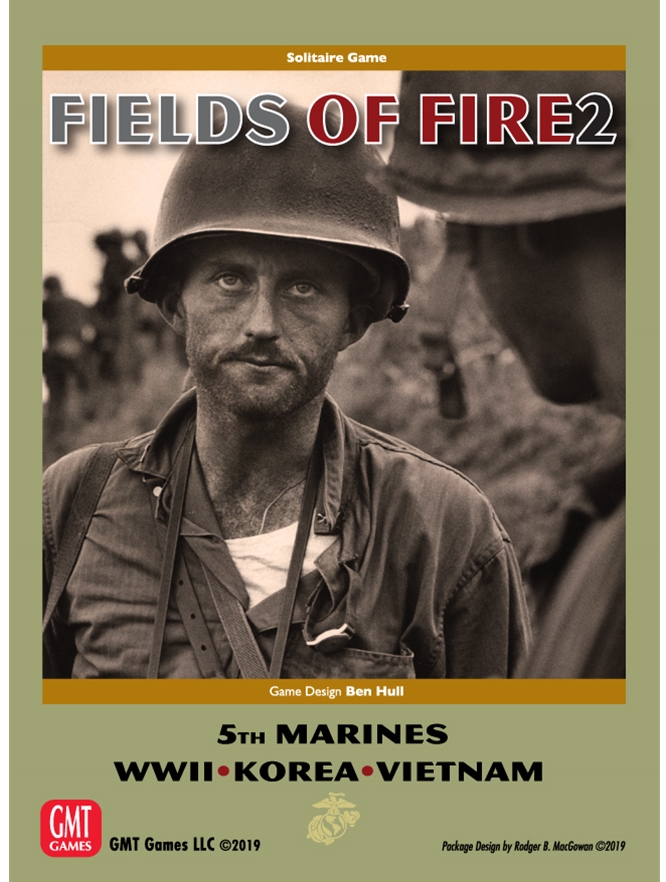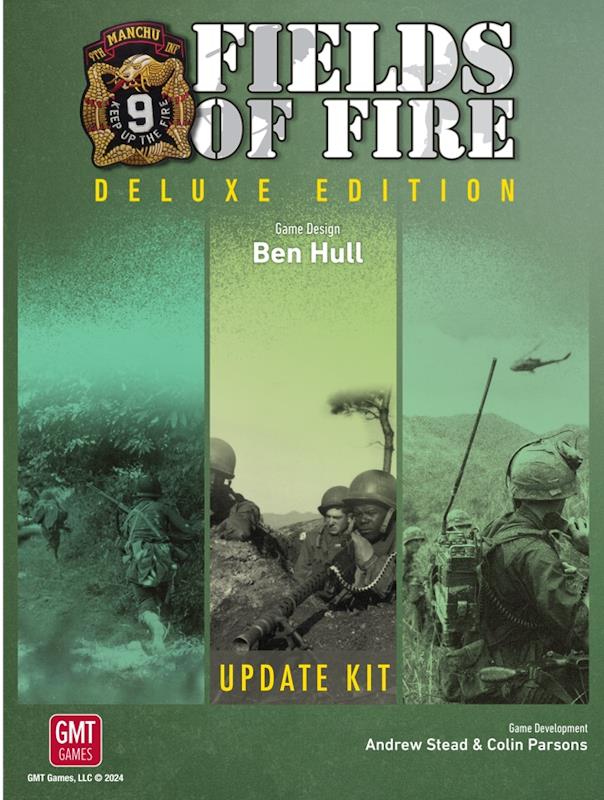A good historical war game puts you in the conflict, letting you play out the scenario while immersing you in its particulars. The factions, the place, and the people. A great historical war game does all that and makes every decision crackle with tension and excitement. Fields of Fire, a solo war game by Ben Hull and published by GMT Games, is such a title. Today we’ll be taking a look at the upcoming deluxe edition, though for anyone eager to jump in right away, the original remains as fun as ever.
Following the exploits of the 9th US Infantry Regiment through World War Two, Korea, and Vietnam, Fields of Fire puts you in the shoes of an infantry commander, trying to accomplish your mission while getting your boys out alive.
How to Play Fields of Fire
Playing Fields of Fire means shedding some familiar tools. For one, there’s no dice. Cards drive the action here rather than lucky rolls, and you’ll draw those  cards throughout the game’s phased turns as your squad attempts missions. These occur on a card grid laying out a mission’s terrain, at once dynamic and constrained. Fields of Fire, as a solitaire game, respects your space and doesn’t require a massive table or pinned up map to play. Your troops will advance through this terrain bit by bit, firing, charging, or suppressing to make room for a flanking maneuver on the other side.
cards throughout the game’s phased turns as your squad attempts missions. These occur on a card grid laying out a mission’s terrain, at once dynamic and constrained. Fields of Fire, as a solitaire game, respects your space and doesn’t require a massive table or pinned up map to play. Your troops will advance through this terrain bit by bit, firing, charging, or suppressing to make room for a flanking maneuver on the other side.
Handling all this action comes via a set phase-by-phase action list, with elements determined by draws off the Action deck. These narrative-generating cards deliver conflicts, offer a chance for enemies and allies to move, and set the flow. You’ll draw repeatedly every turn to determine how many commands each force might get, which can either be saved or used to issue orders to soldiers in the field. That same Action deck drives combat results too, with effects changing depending on terrain, weather, troop experience, and more. It’s as fast and dynamic as any CRT, and eliminates the calculation time, a key factor in a solo game where you’d otherwise be finding your way on a table time and time again.
Because Fields of Fire is a campaign-oriented game, you’ll be building your squad up from one mission to the next, and dealing with casualties along the way. As I noted above, experienced troops come with advantages, so gauging when to risk your veterans is a key factor in success. Fields of Fire is a tactical game, but throws a lot of options your way. Using all the tools at your disposal to dispatch the enemy, conquer objectives, and do so while maintaining your force requires real skill, not just luck. Good mission prep matters almost as much as tactical brilliance, while relying on a lucky card draw won’t carry you through. As a result, I’d put Fields of Fire up there for folks with war game experience, ones who aren’t spooked by realistic force compositions and options beyond just spraying fire at the enemy.
Your reward will be a deep and rewarding series of campaigns stretching over decades, with most missions lasting between 1-4 hours. You’ll get to know your squad, praise their accomplishments and feel the gut punch when one of them takes the wrong bullet. While other systems might abstract out much of the details, Fields of Fire brings you into the crunchy grit of war, and you won’t want to get out.
Fields of Fire: Deluxe Edition
Fields of Fire originally came out in 2008, a time so long ago as to be ancient history (at least in tabletop terms, and possibly my own life). The original production was and remains a great one, but lacked the tutorial support we see in more modern war games. In short, Fields of Fire rewarded your patience and ability to grit through rules with one of the best solo war games out there. A second edition in
and ability to grit through rules with one of the best solo war games out there. A second edition in
In 2025, GMT is making the adventure easier to get into with Fields of Fire: Deluxe Edition, available for pre-order now and releasing soon (as in, it’s coming off the boat this very minute). A major rulebook revision (considered a 3rd edition ruleset) deserves its call-out, with ambiguities and edge cases fleshed out to make play as easy as possible.
A new starter guide comes in too, breaking down the game’s various elements into piecemeal learning scenarios so your poor soldiers won’t get annihilated within minutes of starting a campaign. Similar to Advanced Squad Leader’s various kits, you’ll get packaged info about, say, vehicles or air assaults in nuggets designed to leave you familiar with the concept without clogging the brain. Couple this with a free-standing ‘starter mission’ that can be tackled with various degrees of rules grit, and a game that once was daunting in its complexity becomes, if not easy, much more approachable.
Rules updates aren’t the only reasons to start your Fields of Fire journey with the deluxe edition – everything here has been designed with player ease in mind. Revamped player aids keep you out of the rulebook, while updated campaign books improve clarity and formatting for every scenario, getting you into the action faster. Oh, they’ve glossed the counters and updated some of the more ambiguous cards too. In short, it’s the sort of thing you’d want from a deluxe edition.
This doesn’t mean the original or, especially, 2019’s Fields of Fire 2 are rendered obsolete. Both games remain great, and if you’re a dyed-in-the-wool war gamer, you might be able to pick these up at a discount once its shinier brother arrives.
Games like Fields of Fire
Solo wargaming continues to grow in popularity, with many games (and publishers) now having both solitaire-specific systems and solo-suitability rankings  for every title. With that in mind, looking at Fields of Fire’s squad focus, here are some other war games that fall into a similar mode:
for every title. With that in mind, looking at Fields of Fire’s squad focus, here are some other war games that fall into a similar mode:
Tank Duel: Enemy in the Crosshairs – Also card-based, Tank Duel is exactly what you’d think from the title. You’ll be managing your armor while attempting to annihilate the enemy, whether that’s an AI-driven one or another player. Relatively lightweight, with lots of fun decisions, Tank Duel is a great time (and is technically playable with up to 8 players, for those of you crazy enough to try).
D-Day at Peleliu – The entire D-Day series is designed with solo in mind, and while it’s more classic hex-and-counter, the focused scenarios are tense (amphibious landings!) and the enemy merciless. In-depth, with enough random events to keep things interesting, the D-Day series belongs on any solo war gamer’s shelf.
Atlantic Chase – Hunting the enemy through the Atlantic Ocean’s fog of war is exhilarating thanks to Atlantic Chase’s unique movement system, which is essentially Schrödinger’s Navy. Ships can be anywhere along a route, with their true position only finalized when a landing’s reached or the enemy finds you. A unique experience buttressed by a long, fun selection of scenarios to work through. Great solo or as a devious cat-and-mouse duel with a friend.
The Warfighter Series – Guide your specialized squad through missions and campaigns. You’ll start every session by outfitting your soldiers before diving into a 30-60 minute mission, chucking dice, dealing with ammo, covering fire, and more. Intense, fast, and full of emergent narrative, Warfighter’s worth a look as both a stepping stone to Fields of Fire and as a deep system in its own right.
Soldiers in Postmen’s Uniforms – Essentially a siege game, with you playing as the besieged postal workers on the opening day of World War 2, Soldiers gives you limited actions to try and hold out against waves of attackers. The odds are long, but that makes success all the sweeter while you dive into a heroic story not often told. The lighter weight and slim, though well-done, production helps ensure you can play this one almost anywhere.
The Plum Island Horror – Okay, so this one’s a bit different (Horrors!), and designed by Dawn of the Zeds crafter Hermann Luttmann, but puts you (and potentially a few friends) into the shoes of several unique factions trying to save Plum Island from, well, those horrors. Tactically sharp and irreverent, this is both a companion to Zeds and a good step up from co-op scrambles like Pandemic.
potentially a few friends) into the shoes of several unique factions trying to save Plum Island from, well, those horrors. Tactically sharp and irreverent, this is both a companion to Zeds and a good step up from co-op scrambles like Pandemic.
Fields of Fire has earned its deluxe edition through fifteen years of fantastic play, and whether you’re looking for an excuse to revisit this classic or want to dive in for the first time, Fields of Fire serves as a standard for what’s possible with solo campaign war games, card-based combat, and squad-level design.
